Evolution Final Exam
1/57
There's no tags or description
Looks like no tags are added yet.
Name | Mastery | Learn | Test | Matching | Spaced |
|---|
No study sessions yet.
58 Terms
What is a cryptic species?
A species that looks very similar to another one
What is the biological species definiton?
a group of actually or potentially interbreeding populations, which are reproductively isolated from other such groups
What are the problems with the biological species concept?
Asexual organisms (protists, fungi, bananas)
Extinct organisms
Must revert to morphology
Ambiguous situations in nature
What is the phylogenetic species concept?
Species are the smallest possible group descending from a common ancestor and recognizable by unique, derived traits
General Lineage Species Concept
Species are metapopulations that exchange alleles frequently enough to comprise the same gene pool
What are the barriers to gene flow?
prezygotic barriers
postzygotic barriers
What are the different prezygotic barriers?
ecological isolation (timing, habitat)
behavioral isolation (species specific signals or mating rituals)
mechanical isolation (anatomical)
gametic isolation (sperm survivorship in females, molecules on egg coats)
copulatory behavioral isolation
What are the different postzygotic barriers?
Intrinsic: hybrid fitness is low independent of environment (hybrid viability or fertility is reduced)
Extrinsic – hybrid fitness depends on context (ecological inviability, behavioral sterility)
What is hybrid breakdown?
First generation viable and fertile, next generation is feeble or sterile
Why does genetic divergence happen in humans after the land bridge goes away?
Genetic drift, natural selection, sexual selection
What is reinforcement?
The increase in reproductive isolation between populations through selection against hybrids
Why will lions and tigers breed?
Decision rule: “ok to mate with large, chunky big cat”
lack of reinforcement
What is Allopatric speciation?
speciation that occurs when the initial block to gene flow is a geographical barrier that physically isolates the population
What are the two types of allopatric speciation and what do they mean?
Vicariance: divergence of two large populations
Peripatric: divergence of a small population from a large ancestral population
What are the 2 processes that cause allopatric speciation?
geological processes
dispersal into a new area
impact of barriers and likelihood of long-distance dispersal are dependent on what
mobility of species
What is sympatric speciation?
Reproductive isolation evolves without geographic isolation
What are the mechanisms of sympatric speciation?
Disruptive Selection (Ecological Speciation) w/ Sexual Selection
Individuals begin to mate nonrandomly, i.e,. Mate more often with those that are genetically or phenotypically closest to themselves.
Polyploidy
Polyploid populations are reproductively isolated by postzygotic barriers from their diploid progenitors
What is an allopolyploid?
A polyploid derivative of a diploid hybrid between two species
What is parapatric speciation?
Evolution of new species within a spatially extended population that still has some gene flow
Isolation by distance & ecological adaptation
How much change is required for speciation?
No generalities can be made about genetic distance, but it’s Few loci if involved in reproduction; many otherwise
Why is there huge variation in speciation?
Drift vs. selection
Ecological selection vs. sexual selection
With or without reinforcement
Underlying genetic variation
Polyploidy & hybridization vs. gradual change
Why is the phylogenetic species concept difficult when it comes to microbes?
Some can share 99% of DNA but still be considered different species because they do different things while others are considered the same thing and are only 3% similar. Horizontal gene transfer very frequent.
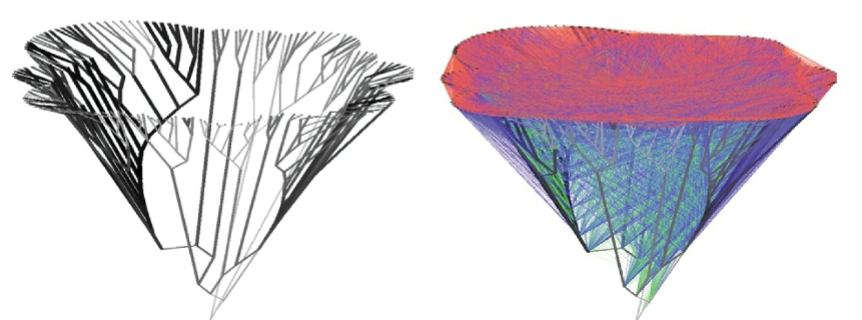
What is the stable ecotype model?
When lineages of microbes adapt to a particular ecological niche – one that is distinct from the niche of other lineages, it is appropriate to call them a species
What are some macroevoltuion questions?
How does geography relate to Evolution?
Why do some places have more species than others?
Why are some clades more specious than others?
What causes species radiations?
What causes mass extinctions?
Definition of Macroevolution
Evolution occurring above the species level, including the origination, diversification, and extinction of species over long periods of evolutionary time
What explains the current distribution of marsupials?
Extinction, dispersal, and vicariance
Population size equation
Population size (Nt+1) = Nt + (births + immigration) – (deaths + emigration)
What is the species diversity equation? locally and globally
local: Diversity (Dt+1) = Dt + (origination + immigration) – (extinction + emigration)
global: Diversity (Dt+1) = Dt + origination – extinction
What is turnover
The disappearance of some species and their replacement by others
Turnover rate is the number of species eliminated and replaced per unit
time.
What is standing diversity
Number of taxonomic units present in a particular area at a given time.
Overall standing diversity can increase when
1. origination increases
2. extinction decreases
Anagenesis
wholesale transformation of a lineage from one form to another
An alternative to splitting lineage or speciation
Punctuated equilibria
periods of stasis punctuated by brief periods of rapid change
Often associated with speciation events
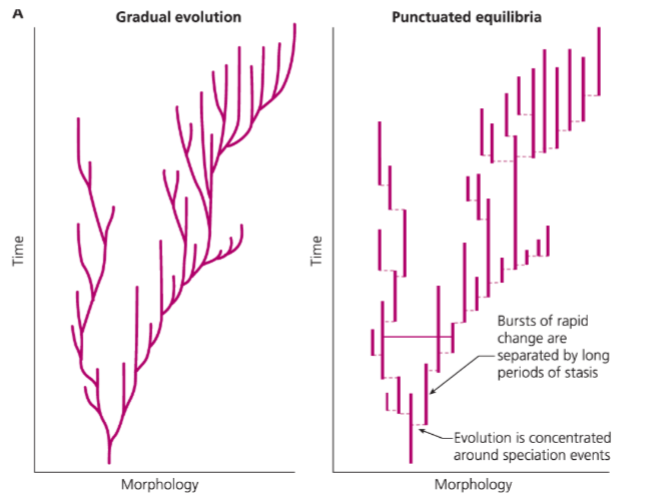
Gradualism
Slow, gradual morphological changes over time
Can include speciation events; traditional view
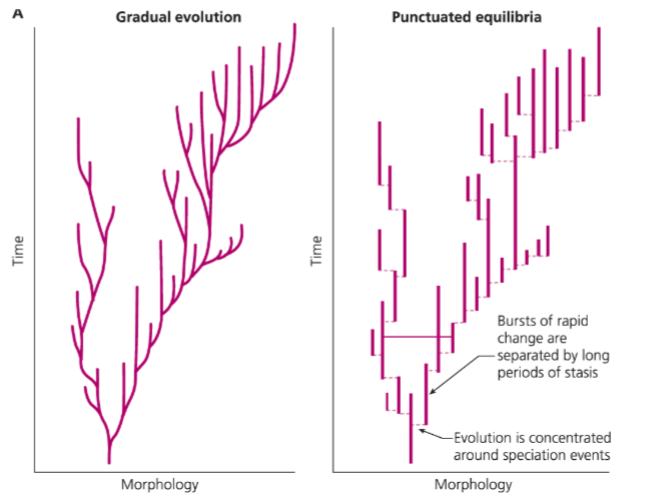
What are the two possible scenarios for incomplete fossil records
gradual morphological change with no speciation
rapid speciation and morphological change
What causes alpha (origination rate) to eclipse omega (extinction rate)
lack of competition (loss of clade, new colonization of habitat)
key innovation (transforms how organisms interact with their environment
Overall biodiversity can decrease when
origination decreases
extinction increases
Coevolution
Reciprocal evolutionary change between ecologically intimate species, driven by natural selection
Prerequisites of coevolution
Heritable variation in traits relevant to interactions
Reciprocal selection
What is required for reciprocal selection?
Variation in response between populations of the 2 species
Population size, mutation, genetic variation, pleiotropy
Type of selection (directional vs. frequency dependent)
Type of interactions (mutualistic vs. antagonistic)
Variation in # of partners in the interaction
what does reciprocal selection result in
geographic variation
Geographic mosaic theory of coevolution
Variation in type of selection
Variation in strength of selection
Variation in evolved response to selection
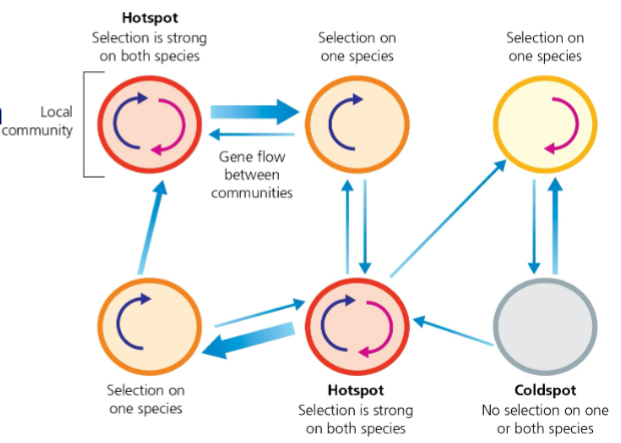
What is coevolution “Red Queen”
Lots of parasites on the common host genotype → Common host genotype becomes rare, other host genotypes get advantage due to higher fitness, parasite is selected for differently → The rare host genotype becomes common, parasites that live on the new common host genotype will have higher fitness
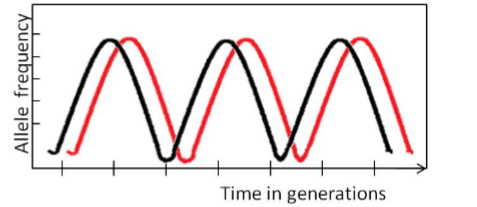
What is the coevolutionary arms race
Interactions in which antagonistic players get caught in an escalation of ever-increasing abilities
Prey evolves a defense against predation → Predator responds evolutionarily to counteract the defense
(Fitness costs are typically higher for prey than for predators)
What is needed for a coevolutionary arms-race to occur?
Both predator & prey species exert strong selective pressures on each other (reciprocal selection). hot spots (matched abilities) vs. cold spots (mismatched abilities)
Genetic variation in prey & predator traits
Why can a coevolutionary arms race not occur even when there’s genetic variation in prey and predator traits and both species exert strong selective pressures on each other?
because of interactions with other species, energetic costs of production of traits, & abiotic factors
Snakes can quickly evolve strong resistance to the newts, whereas it is harder for the newts to evolve a more potent toxin. Why?
Because there’s trade-offs for newts (like less offspring)
The myxoma virus becoming less viral to spread more easily in Australian rabbits was an example of what
Attenuated coevolution (decelerated arms race)
What reinforces mutualistic relationships
positive frequency dependent selection
Mullerian mimicry
several harmful or distasteful species resemble each other in appearance facilitating the learned avoidance by predators, mutualistic (if too many batesian mimic happen, mutualism will collapse)
Batesian mimicry
Not mutualistic, one non non harmful species mimicing a harmful one, cheating
True or false, mutualism can become antagonisms
True, if one cheats, the other will punish
What questions do you ask when comparing phylogenies of several groups to test and reconstruct coevolution
Do the phylogenies match?
Have the two groups evolved and speciated in parallel?
